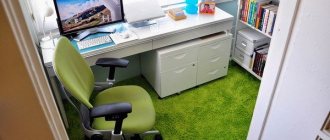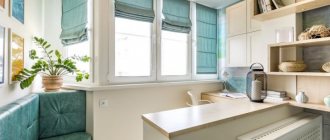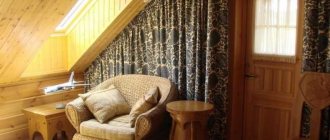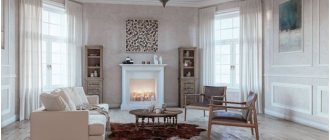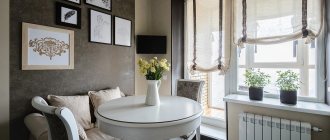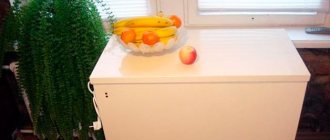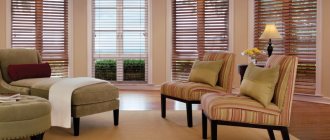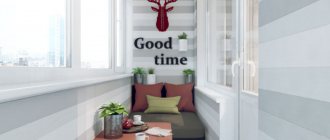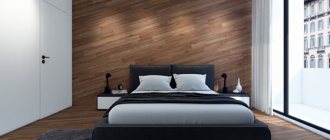The color of the walls shapes the atmosphere in the house. The right choice determines what emotions you will experience while in the room: inspiration and relaxation or, conversely, fatigue and irritation. The same can be said about the interior of a loggia or balcony, which often play the role of a full-fledged living room in a modern apartment. The choice of colors for these rooms has its own characteristics. To decide what color to paint the balcony, you need to take into account the small dimensions of this room, the general style of the interior, as well as the openness of its walls to ultraviolet radiation. We will try to understand all the intricacies of these issues today.
What should you pay attention to when choosing a color?
From physics course we know that a dark surface attracts and absorbs light waves. While light is reflective. If you make light walls and a dark floor, the light will be reflected from the former and absorbed by the latter. This way you can make the floor warmer. For a balcony facing south or east, rich, intense wall colors are more suitable. If the windows of the loggia face north, then light pastel colors are preferred.
Good to know! Sunlight can warm, but under its influence the paint fades. And this is more noticeable, the more saturated and bright the color. This primarily applies to black.
While white in the sun often takes on a yellow tint. Shades of gray are least susceptible to such negative influences. Therefore, if you intend to make a thorough renovation and not update it for a long time, then you should pay attention to this color for the loggia.
If the windows face north, then light colors in the decoration are preferable
Balcony paint: main types of paints
Painting the balcony must comply with certain requirements:
- Safety of materials for human health and the environment.
- The ability of the paint to withstand the influence of negative external factors - not to be washed off with water, not to fade in the sun, not to crack in the air, etc.
- Vapor permeability - so that moisture cannot accumulate in the walls.
Thus, several types of paints have become common for everyday use.
Acrylic
They are water-based, so they are suitable for interior decoration of any residential premises. Acrylic paint for balconies is easy to apply, diluted with water, does not smell anything and dries in a few hours. It has high resistance to abrasion and ultraviolet radiation, good vapor permeability and tinting that allows you to get a wide range of colors. Average paint consumption (with a two-layer coating) is 500 g per 1 sq. m. The result lasts 10 years.
Silicone
They have the longest service life - 20 years, but take a long time to dry out and have an unpleasant odor. Silicone paint forms a durable water-repellent coating and, due to its excellent plasticity, makes it possible to paint over noticeable defects. Resistance to abrasion and heat is high, in addition, the composition usually includes antibacterial additives, which eliminates the appearance of mold. To paint a balcony in one layer, you need to spend 200 g of paint per 1 square meter. m.
Latex
They form a waterproof film on the surface, dry quickly, but have low vapor permeability and are less resistant to ultraviolet radiation. Latex paint can be used to paint over minor defects in walls - cracks and small holes.
Alkyd
They are a mixture of synthetic resins and dye in a solvent, so they have a strong smell and are also washed off only with solvents (white spirit). They have good water-repellent properties, are resistant to impact loads, and create a dense film. At the same time, alkyd paints for balconies dry faster than oil paints.
Silicate
The material is based on liquid glass, which provides very strong adhesion to the surface. Because of this, silicate paints are difficult to remove, but are resistant to aggressive chemicals and ultraviolet radiation, as well as temperature changes. They perfectly permeate moisture, and their hardening time is 24 hours.
Water-based
They are considered obsolete due to high abrasion, poor resistance to low temperatures and rapid crumbling. But this paint can be used to cover ceilings on insulated balconies and loggias - if there is a need to save money.
The influence of color on the human psyche
According to observations, the color scheme in a room can influence a person’s mental state. So the red color encourages action and activates. Shades of blue calm and enhance concentration. Yellow tones the nervous system and gives strength.
A room with orange walls is a good place to relax, recover after a hard day, and also to engage in creativity. However, its excess in the interior leads to absent-mindedness.
Green and light green stimulate mental activity and improve vision. White color is associated with space. But its excess in the absence of other colors makes the room uncomfortable. Purple helps reduce anxiety and encourages creativity.
Required Tools
It is more efficient to paint walls and ceilings with a roller, which gives an even coating. And paint all corners and narrow elements (the same window frames) separately with a brush. But here it can be difficult with the intensity of the color - the brush gives a thicker coating. This can be avoided by stirring the paint in the can not only before starting the repair, but also during the process itself. This way the shade will apply evenly.
It is better to buy a mohair roller, and brushes should work well on a rough surface (this will be specified when purchasing). These tools are affordable and easy to replace if necessary. Also, if the coating is porous and you want to make the surface as smooth as possible, you can buy special sealants.
When using varnishes, it is better to get a paint sprayer, because it is easier to create a smooth coating without borders or smudges. Professionals can do this with ordinary tools, but it is difficult to achieve this with your own hands.
Color combinations
The right combination of colors on the balcony can change the visual perception of the room. To visually “expand” a small space, it is enough to paint the walls in pastel colors. You can reduce the length of a long loggia. By making the smaller wall darker in relation to the others.
Using paint in a soft, muted color, you can hide defects and surface irregularities, making them less noticeable. To achieve the desired visual effect, several colors are usually combined in the interior. Let's take a closer look at their compatibility with each other.
- White. Universal background color. Combines with almost all shades of the palette.
- Orange walls are combined with a green carpet or flooring. It is important that all interior colors have the same degree of saturation.
- Shades of pink and beige. With their help, you can implement a popular architectural technique on the balcony - zoning. For example, if the base color of the walls is milky, then by painting one of the walls in a rich fuchsia shade and choosing carpeting the color of baked milk, we get an excellent relaxation area.
- Spice color. If desired, you can design the interior of a loggia or balcony in the exotic style of a North African home. For this, warm, rich tones of oriental spices such as hot cinnamon, turmeric and cardamom are suitable. They harmonize perfectly with the light yellow and beige main colors of the walls. Furniture in mahogany or wenge color will complement the interior.
- Blue. This cool color is ideal for a balcony. Especially if you plan to turn it into a recreation area. It is both calming and relaxing. The light blue color of the loggia goes well with rich blue on the walls and gray shades for the ceiling and floor.
- Earthy natural shades evoke an association with the natural environment and its natural colors. An example of a successful combination of such shades: the warm texture of wooden paneling harmoniously coexists with surfaces of sand and brown colors. This creates a warm atmosphere that is soothing and pleasing to the eye.
White color goes well with any other color
Painting different surfaces
Initially, balcony walls are concrete or brick and plaster. But finishing and insulation make the surface different, and it is not clear how to paint a balcony if it has a wooden, plastic, metal or even stone covering?
Concrete, brick, plaster
Such a balcony should first be finished for painting - clean the surface and treat the moldy areas, apply a primer. For cleaning, sandpaper, metal brushes and even a grinder are used. Any cracks and potholes are filled with putty or cement. It is better to choose a brush that can penetrate into deep pores (these materials are characterized by roughness). Acrylic, silicate, latex, and silicone paints are suitable.
Drywall
According to the technology, after fastening, drywall panels are covered with putty and rubbed with abrasive materials to create a smooth surface. So painting requires just a layer of primer, and water-based paints are best suited for this - in the case of a balcony, these are acrylic and water-based. Usually you need two or more layers of paint, the last one going in the direction of the light.
Wood (including lining)
Painting a balcony with a fiberboard or chipboard finish should be carried out after preparing the surface - for this, use olive, oxol or alkyd primer on penaflalic varnish. This reduces paint consumption and creates an additional protective film on the wood. These surfaces are often coated with clear varnish, but alkyd paints and varnishes provide equally impressive results. To save money, you can use regular oil paints, which take a long time to dry.
If there are wooden frames on the balcony, they also need to be prepared - cleaned, coated with drying oil (in two layers) and primer. Irregularities are corrected with putty. In this case, the frames and wooden doors need to be painted with different compounds than the walls.
Plastic
Typically, additional coating is required when siding or panels become faded in the sun over time. For this purpose, there are special paints for PVC products, which are produced in spray cans; they extend the service life of the finish. But before painting, it is also better to clean the panels: remove them, treat them with a solvent (it can be replaced with alcohol), hang them back and then apply paint.
Profile sheet
After 10-15 years of operation, traces of corrosion appear on such a surface, and painting it is cheaper than dismantling and installing a new corrugated sheet. But before applying paint, rust must be removed - with sandpaper or a means for converting it. It is also usually necessary to remove traces of oil stains and remnants of old paint. After this, alkyd materials are often used.
A selection of design ideas
Let's look at the photographs that show interior design ideas.
Premises with an area of 3 sq. m
PVC panels were chosen for covering the walls of the room. This method is one of the most practical and does not require large investments of money and time for installation. The texture of the panels is perfectly complemented by PVC window frames, the surface of which imitates wood.
Relaxation area on the balcony with an area of 3 sq. m. A pastel range of shades was used as a basis, complementing the interior with active colors through decorative items, furniture, and light sources. A panel with a city perspective fits into the general idea of the style and creates the atmosphere of a street in Paris.
The cabinet is designed specifically to save space and maintain order - with panoramic glazing, the area can be seen from the street if there is no tinting. The ironing board does not interfere with the passage into the apartment. Furniture material: painted chipboard elements. The walls are lined with black ceramic tiles in the shape of a brick.
Design of a balcony of 3 square meters. m in black and white. Chairs, coffee table, carpet, pillows, dishes and decorative items - everything is designed in the same style.
Modern interior. Finishing with natural materials - wood, decorative plaster, textiles.
Decorative plaster in the design of a hookah room (3 sq. m).
Loggia – continuation of the apartment
Two rooms are combined into one. The balcony area includes a dressing table with a pouf and a built-in wardrobe.
Where to start the renovation?
First, decide whether you want to see the balcony as an independent room. Or perhaps it would be more logical to attach it to the kitchen or room?
Photo: Sergey Krasyuk. Stylist: Daria Soboleva
Photo: Sergey Krasyuk. Stylist: Daria Soboleva
Photo: Instagram @lichic.de
Photo: Instagram @lichic.de
Photo: Instagram @anna_khromova_design
Photo: Instagram @anna_khromova_design
The second important point is glazing. If you can’t imagine your life without summer breakfasts outdoors, it would be logical not to glaze the room. If you decide to add space or create a separate living area here, you cannot do without glazing.
Design: Julia Ruzo
Design: Julia Ruzo
Photo: Instagram @tvoy_balcon
Photo: Instagram @tvoy_balcon
And finally, the third point that you should decide on before planning the interior is insulating the loggia. When arranging a living space, insulation is a must. If you are going to store things here that are not particularly sensitive to changes in humidity and temperature, or use the room exclusively as a smoking area, you can refuse insulation.
Photo: Instagram @alexey_volkov_ab
Photo: Instagram @alexey_volkov_ab
How to paint with your own hands
The process of finishing the walls on the balcony requires preparatory steps and proper painting. To avoid common mistakes, it is worth studying the instructions for renovating the space in advance.
Puttying
Applying putty forms a flat and smooth surface, eliminating all defects. The putty mixture is applied in one layer, leveled with a suitable tool and wait until it dries.
Primer
Priming is carried out before applying putty for improved adhesion of the top layer to the wall. To apply the primer, use a special roller.
Painting
The painting technology depends on the type of base and the chosen coating. Recommendations for applying a specific composition are usually indicated by the manufacturer on the paint packaging.
All finishing work on the balcony is carried out at temperatures above 10 degrees.
Thematic video from professionals
Tips from the pros will help you understand the nuances of finishing a balcony:
Video instructions for painting walls
How to apply textured paint correctly
The use of paint, varnish and other decorative materials is an affordable and effective way to improve a balcony or loggia. Almost all stages can be completed independently, without the involvement of specialists. If you approach this event with desire and imagination, you will get another beautifully decorated room - cozy and comfortable.
YOU MAY ALSO BE INTERESTED
Design features
To select the desired design for a white balcony, you can use a wide variety of materials. This includes the following materials:
- siding;
- lining;
- plastic panels;
- decorative rock;
- plasterboard slabs.
Any of the above materials can be painted white. This will increase the visual space inside the balcony.
Decorative rock
The finishing with decorative stone in white tones deserves special attention. It is a good option for interior decoration of a balcony.
This material has a number of advantages:
- has a small tile thickness and light weight;
- does not clutter up the space, works well in confined spaces;
- allows you to hide defects in the wall and balcony structure.
The use of these tiles painted white will brighten up the interior of even the smallest balcony. When working with this material, it is necessary to select the correct glue and appropriate tools.
Lining
Natural wood has always enjoyed special respect. This material looks great in a combination of white and varnish.
Its features are as follows:
- such material matches any interior design;
- the lining is light weight, it is easy to carry out installation work;
- it is an environmentally friendly material.
This material has an excellent aesthetic appearance and allows the use of thermal insulation and sound insulation of the room.
Loggia furniture
- To be able to transform the space, it is better to purchase folding furniture models;
- Instead of a bed that will take up the entire area, you can use a hammock for the relaxation area. If necessary, its structure is dismantled, freeing up the premises.
- If the loggia is small, you should use compact items when decorating the interior of the room. For example, open shelves are used for storage - such designs look easy, and at the same time help to properly organize the space.
A relaxation area with a hammock and pillows allows you to use several levels at once in one space. In such a room a company of 4-6 people can gather for a pleasant conversation.
Open shelves perform not only a functional role, but also a decorative one - they serve as a color accent in this interior.
Preparing the wall
Any painting work begins from this point. Some modern paints, for example, those with a latex base, are able to smooth out minor surface defects and “tighten” shallow cracks. However, such compositions are not intended to strengthen the structure, so you should definitely prepare the surface before painting.
Work algorithm:
- Clean the walls from the old coating, remove all loose pieces of plaster, bricks or mortar.
- If necessary, perform bactericidal treatment of the surface against fungus and mold.
- Clean the surface from dust and dirt, preferably blow it with compressed air if you have a compressor. An alternative is to use a household vacuum cleaner.
- Prime the wall with a special moisture-resistant compound. This will improve the quality of the coating and also provide additional waterproofing properties.
- Seal seams and detected defects using compounds suitable for outdoor work.
- Re-prime the treatment areas.
Depending on the chosen interior style and the condition of the brickwork, one more item can be included in this list - plastering the surface. For this purpose, moisture-resistant compounds for universal use are used. They are more expensive than usual, but will provide additional resistance to adverse weather conditions.
